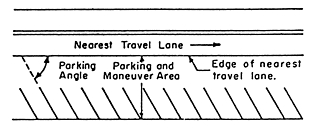 |
Pennsylvania Code (Last Updated: April 5, 2016) |
 |
Title 67. TRANSPORTATION |
 |
PART I. Department of Transportation |
 |
Subpart A. Vehicle Code Provisions |
 |
Article VIII. Administration and Enforcement |
 |
Chapter 212. Official Traffic-Control Devices |
 |
SubChapter B. SIGNS |
Section 212.114. Stopping, standing and parking restrictions
-
(a) General. Stopping, standing or parking may be restricted along the curb or edge of a roadway when one or more of the following conditions exist:
(1) The distance between the center of the center line pavement markings (or the center of the roadway if center line pavement markings are not present) and the curb or edge of roadway is less than 19 feet on major arterial highways, or less than 18 feet on other roadways.
(2) The street width is such that, if vehicles are parked along one or both curb faces or edges of the roadway, two vehicles cannot move abreast of one another in the same or the opposite direction without one yielding to allow the other vehicle to pass.
(3) A capacity analysis indicates that parking should be removed at all times or during certain hours to accommodate the traffic volume.
(4) At an intersection, the available corner sight distance for a driver on the minor road is less than the necessary minimum stopping sight distance value for the driver on a through roadway.
(5) An analysis of vehicle crashes indicates that at least three crashes during the previous 3-year period have been directly or indirectly attributed to one of the following primary causes:
(i) Vehicles parking on the roadway.
(ii) Vehicles entering or leaving the parked position.
(iii) Drivers or passengers getting out of parked vehicles on the street side.
(iv) Reduced sight distance due to the parked vehicles.
(6) The area is designated as an official bus stop or as a loading and unloading zone.
(7) The area is adjacent to or opposite of a fire station driveway or any other type driveway or intersection where turning maneuvers would be restricted if parking were present.
(8) The width of the shoulder is not sufficient to allow a vehicle or its load to park completely off the roadway.
(9) Along roadways having three or more lanes and speed limits of 40 miles per hour or above, parking may be restricted to allow vehicles to use the berm or shoulder as a clear recovery area.
(b) Angle parking. As defined in § 212.1 (relating to definitions), angle parking will only be authorized as follows:
(1) New angle parking may be established only along streets where the following criteria are satisfied:
(i) The parking and maneuver area, as shown in the diagram which follows, adjacent to the near edge of the nearest travel lane equals or exceeds the distance indicated in the following table:
Parking Angle
(degrees)Parking and Maneuver
Area (feet)30 26 45 30 60 37 90 43 
(ii) Parked vehicles do not adversely affect the available corner sight distance.
(iii) Additional travel lanes are not required for the existing traffic volumes to achieve a satisfactory level of operation.
(iv) Parking stalls will be adequately marked and spaced.
(v) Pedestrian activity is minimal within the parking maneuver area.
(2) It is recommended that existing angle parking be eliminated if an analysis of vehicle crashes indicates that the parking-related crash rate within the area of existing angle parking is greater than the rate on similar portions of the same street or other streets within the same municipality which have parallel parking.
(c) Parking meters. When parking is permitted, local authorities may install parking meters and appropriate pavement markings to designate parking stalls. The hours of effectiveness of parking meters must be indicated either on the meter or within the dome of the meter, but official traffic signs shall be erected to indicate hours when parking is prohibited.
(d) Prohibition of kinds and classes. When parking is permitted, local authorities or the Department may prohibit certain kinds and classes of vehicles from parking for safety, capacity or environmental reasons. Official signs must indicate the prohibitions.
(e) Parking reserved for persons with disabilities. The Reserved Parking Penalties Sign (R7-8f) shall be installed below all Reserved Parking Signs (R7-8), as provided in 75 Pa.C.S. § 3354(d) (relating to handicapped persons and disabled veterans).
(f) Miscellaneous restrictions.
(1) Local authorities or the Department may restrict or regulate parking without an engineering and traffic study to accomplish the following:
(i) Facilitate construction, maintenance or utility operations.
(ii) Eliminate long-term parking or parking in excess of a specified time limit.
(iii) Provide for reserved parking spaces.
(iv) Provide for snow emergency routes.
(v) Provide for mail delivery or pickup.
(2) Restrictions for the elimination of long-term parking must apply only during short periods of time such as early morning hours when it will not seriously inconvenience local residents.
(g) Double parking. When parking is permitted, local authorities may, by local ordinance without an engineering and traffic study, authorize double parking (standing or parking on the roadway side of a vehicle stopped or parked at the edge or curb of a roadway) for the purpose of loading or unloading persons or property. On State-designated highways, double parking is not permitted without written approval of the Department.
(h) Authority. Local authorities may establish, revise or remove stopping, standing or parking restrictions on State-designated highways within their physical boundaries, except Department approval is required prior to revising or removing any of the following:
(1) Established in conjunction with a State or Federal aid project.
(2) Requested or posted by the Department for safety or capacity reasons.
(3) Included as a condition on a traffic signal permit.